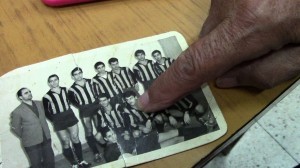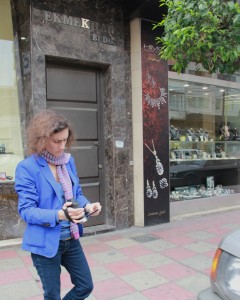Engaged Anthropology Grant: Joanne R. Nucho

Joanne R. Nucho is a postdoctoral scholar in anthropology at the University of California, Irvine. In 2010, she received a Dissertation Fieldwork Grant to aid research on ‘Producing the Neighborhood without the Nation: ‘Trans-Municipal’ Urban Planning in Lebanon,’ supervised by Dr. William Michael Maurer, aiming to study the relationship between urban infrastructure and cultrual politics and identity in post-Civil War Beirut. She recently received the Engaged Anthropology Grant to follow-up her research with a return to the city to conduct a filmmaking workshop.
I conducted my dissertation research between 2010-2011 in a working class neighborhood outside of Beirut, Lebanon called Bourj Hammoud. Bourj Hammoud is an area full of workshops, mostly small-scale shoe and clothing manufacturing as well as jewelers. It is also a bustling commercial center where many Beirut-dwellers come to shop. Bourj Hammoud is known throughout the greater Beirut area as an “Armenian quarter,” it is, in fact highly diverse with members of various Lebanese sects as well as migrant workers living and working there. My dissertation focused on the ramifications of various urban planning initiatives as well as infrastructures and social service institutions on the formation of sectarian identity and a sense of belonging. During the course of my dissertation research, I used photography and videography to document the ways in which people accessed resources and services like education, medical care, electricity and water in various ways, both through sectarian institutions as well as informal networks.

My plan during my fieldwork research was to make an ethnographic video documenting the networks that people navigate in order to access the services so vital to everyday life. However, while filming, I quickly realized the potential for the process of filmmaking to be much more collaborative in nature. At the time, I taught English at a local social service center to a group of young adults. After I arranged some documentary film screenings at the center, the students expressed interest in making their own films, and it was with this group that I realized the potential for ethnographic filmmaking to serve both as a collaborative research methodology, as well as a means for these young people to conceptualize the ways in which urban infrastructures perpetuate sectarian forms of belonging and facilitate discussion within the community through a screening series.

I returned in December 2013 to conduct a filmmaking workshop in Bourj Hammoud with 8 students. The workshop was designed to provide technical training in videography and basic editing skills. However, and perhaps more importantly, I envisioned it as a forum to discuss issues raised by the various film projects. Lebanese artist and photographer Rosy Kuftedjian served as a guest lecturer and allowed us to use her studio space, which enabled us to meet outside of the regular hours of the social service center where I had initially planned to conduct the workshop. Many of the workshop participants worked or attended classes, so flexibility in meeting hours was crucial. We spent the first several sessions on a number of individual assignments whereby each student documented a typical day in their lives. This initial exercise proved to be invaluable both in terms of allowing the students to become more accustomed to shooting handheld video, as well as encouraging conversations about the role of urban infrastructures in creating a sense of meaning and belonging in various social worlds. For example, one of the students documented two journeys across town using different modes of transportation. In one journey, she took a private, informal “van” service and in another, she took a semi-private “bus.” Filming her journey across town and back made her reconsider all of the ways that peoples’ daily experience of transportation, whether in a private car, a van, a bus or on foot, changed profoundly their experience of the city. Navigating her way across Beirut by bus, using routes that were not printed on a map through neighborhoods that she was not necessarily familiar with was a very social experience that involved asking bus drivers and other passengers for ways to connect to other locations. Our conversation around this preliminary exercise helped demonstrate how the camera was much more than a recording device or a mode of documentation. Rather, it could enable moments of reexamination where the mundane was interrupted by looking again, or “freezing time” through the camera’s lens.

Once the students were comfortable using the cameras and were familiar with basic editing techniques, they collaborated to produce 3 films in the remaining weeks. Each group selected a different topic – informal electricity services, the history of a local shoe workshop, and the memories of an eighty-year old resident of Bourj Hammoud. After each group screened some of their rough footage, we discussed how the films could visually communicate the connections between urban space and urban infrastructures and a sense of belonging to a particular community or even a sense of identity. The two films that dealt with various histories helped challenge some assumptions about Bourj Hammoud as a monolithic Armenian neighborhood, even as they highlighted the history of the first generation of Armenian refugees of the genocide in former Ottoman lands who initially urbanized the area. We compiled many of our thoughts from these discussions into a booklet about how the filmmaking process profoundly transformed the students’ experience of their neighborhood.

At the end of the workshop, the students and I organized a screening of the three edited films in Bourj Hammoud. The screening was a great success, and many of the students felt encouraged to continue to make more films and distribute them online. Rosy Kuftedjian has agreed to serve as an ongoing coordinator for the students, allowing them to store and access the equipment in her studio. I also plan to continue my organizing role in the workshop with participants that I maintain long-term correspondence with who would like to continue their filmmaking practice. I hope to return to Lebanon by the end of 2014. The students also expressed interest in training other students in filmmaking techniques. We are collectively planning to show their films in different venues in the greater Beirut area. Thus, the workshop will have an ongoing impact, with the participants continuing to make and share their work with a wider public.